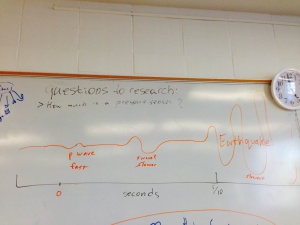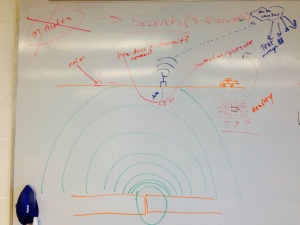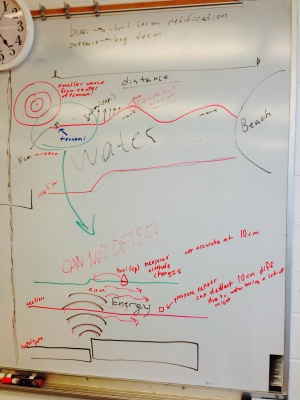Difference between revisions of "Disaster-Preparedness"
Jump to navigation
Jump to search
(→Code Sample) |
|||
| Line 1: | Line 1: | ||
| − | + | =Motion Sensor= | |
| − | |||
Under construction until the end of Fall 2014 semester unless indicated otherwise. | Under construction until the end of Fall 2014 semester unless indicated otherwise. | ||
| − | + | ==Purpose== | |
* Detect and measure motion. | * Detect and measure motion. | ||
* Use multiple cheap, inexpensive sensors to increase accuracy/reliability/functionality. | * Use multiple cheap, inexpensive sensors to increase accuracy/reliability/functionality. | ||
| Line 9: | Line 8: | ||
* Provide data that can be aggregated over a network. | * Provide data that can be aggregated over a network. | ||
| − | + | ==Sensors== | |
We used tilt switches, a piezo element, a laser / photoresistor combo, and an accelerometer. | We used tilt switches, a piezo element, a laser / photoresistor combo, and an accelerometer. | ||
| − | + | ===Tilt=== | |
| − | + | ====Use==== | |
* A tilt switch uses a material to complete a circuit (E.G. press a button) when it reaches either end of the container. | * A tilt switch uses a material to complete a circuit (E.G. press a button) when it reaches either end of the container. | ||
* We used XZ mercury switches. | * We used XZ mercury switches. | ||
| Line 21: | Line 20: | ||
* No noticeable noise. | * No noticeable noise. | ||
| − | + | ====Wiring==== | |
* Power, ground, and signal. | * Power, ground, and signal. | ||
* 10k resistor on power. | * 10k resistor on power. | ||
* Signal is digital. | * Signal is digital. | ||
| − | + | ====Code Sample==== | |
<pre> | <pre> | ||
const int tiltPin = 2; | const int tiltPin = 2; | ||
| Line 40: | Line 39: | ||
</pre> | </pre> | ||
| − | + | ====Resources==== | |
* [[http://en.wikipedia.org/wiki/Tilt_switch wikipedia]] | * [[http://en.wikipedia.org/wiki/Tilt_switch wikipedia]] | ||
* useful code [[http://arduino.cc/en/Tutorial/Button here]] | * useful code [[http://arduino.cc/en/Tutorial/Button here]] | ||
| − | + | ===Piezo Element=== | |
| − | + | ====Use==== | |
* A very cheap, diverse piece of kit. | * A very cheap, diverse piece of kit. | ||
* Can be used as a button, a knock sensor, to detect vibration, to detect sound, or to produce sound similar to a buzzer. | * Can be used as a button, a knock sensor, to detect vibration, to detect sound, or to produce sound similar to a buzzer. | ||
| Line 51: | Line 50: | ||
* Vibration sensitivity is increased dramatically when the piezo element is attached to a solid object by a weight, glue, or tape. | * Vibration sensitivity is increased dramatically when the piezo element is attached to a solid object by a weight, glue, or tape. | ||
| − | + | ====Wiring==== | |
* Signal and ground. Signal serves as power. | * Signal and ground. Signal serves as power. | ||
* 1k resistor on the signal; 10k worked similarly, so 1k+ is probably fine | * 1k resistor on the signal; 10k worked similarly, so 1k+ is probably fine | ||
| Line 57: | Line 56: | ||
* minimal noise | * minimal noise | ||
| − | + | ====Code Sample==== | |
<pre> | <pre> | ||
const int piezoPin = 2; | const int piezoPin = 2; | ||
| Line 71: | Line 70: | ||
</pre> | </pre> | ||
| − | + | ====Resources==== | |
* [[https://www.sparkfun.com/products/10293 product page]] | * [[https://www.sparkfun.com/products/10293 product page]] | ||
* [[http://www.arduino.cc/en/Tutorial/Knock arduino tutorial]] | * [[http://www.arduino.cc/en/Tutorial/Knock arduino tutorial]] | ||
| Line 77: | Line 76: | ||
* [[http://en.wikipedia.org/wiki/Piezo_element wikipedia]] | * [[http://en.wikipedia.org/wiki/Piezo_element wikipedia]] | ||
| − | + | ==Housing== | |
| − | + | ===Case=== | |
| − | + | ===Resonate Frequency=== | |
| − | + | ===Power=== | |
| − | + | ==Code== | |
=Research= | =Research= | ||
Revision as of 17:26, 6 June 2014
Contents
Motion Sensor
Under construction until the end of Fall 2014 semester unless indicated otherwise.
Purpose
- Detect and measure motion.
- Use multiple cheap, inexpensive sensors to increase accuracy/reliability/functionality.
- Be cheap and portable.
- Provide data that can be aggregated over a network.
Sensors
We used tilt switches, a piezo element, a laser / photoresistor combo, and an accelerometer.
Tilt
Use
- A tilt switch uses a material to complete a circuit (E.G. press a button) when it reaches either end of the container.
- We used XZ mercury switches.
- The Y direction wasn't very sensitive. It only seemed useful for seeing if the device had flipped over.
- Tilt switches work best when the motion is parallel to them. This loss of motion can be minimized by adding more sensors at half-steps. For example, we could add a tilt that was inbetween XZ to measure diagonal motion more effectively.
- We looked exclusively for change. This means we didn't care about what state the tilt switch was in, just if it had changed since the last read.
- No noticeable noise.
Wiring
- Power, ground, and signal.
- 10k resistor on power.
- Signal is digital.
Code Sample
const int tiltPin = 2;
int tiltState = 0;
void setup() {
pinMode(tiltPin, INPUT);
}
void loop(){
tiltState = digitalRead(tiltPin);
}
Resources
Piezo Element
Use
- A very cheap, diverse piece of kit.
- Can be used as a button, a knock sensor, to detect vibration, to detect sound, or to produce sound similar to a buzzer.
- We used it as a vibration sensor.
- Vibration sensitivity is increased dramatically when the piezo element is attached to a solid object by a weight, glue, or tape.
Wiring
- Signal and ground. Signal serves as power.
- 1k resistor on the signal; 10k worked similarly, so 1k+ is probably fine
- analog
- minimal noise
Code Sample
const int piezoPin = 2;
int piezoState = 0;
void setup() {
pinMode(piezoPin, INPUT);
}
void loop(){
piezoState = analogRead(piezoPin);
}
Resources
Housing
Case
Resonate Frequency
Power
Code
Research
These are notes and observations from research.
Earthquake
- occur due to movement in tectonic plates
- only seconds of notice, 5-10 seconds
- [p waves] are much faster than [s waves] and the actual waves that cause the earthquake.
- earthquakes travel at about the same speed as data networks
- can be measured by motion (on surface or underground) and pressure (underground)
- downside of underground monitoring is 1) power and 2) transmission
- can use repeaters or solar power to solve these issues
- advantage of being underground is distance from noise (such as animals and humans) and being closer to the source of the earthquake
- being attached to rock is good
- downside of underground monitoring is 1) power and 2) transmission
Resources
Tsunami
- in the deep sea pressure sensors are used to measure the relatively small sea-level change (in centimeters)
- nearer to shore, where waves start to form, altitude could be measured by buoy
- travel at hundreds of miles per hour
- tsunami headquarters in Hawaii
- notification could be minutes to hours in advance depending on distance from source of tsunami
- height/speed of wave reduces with distance


